Situated on the south slope of Mount Rainier, Paradise is arguably the most popular visitor area in Mount Rainier National Park.
It is usually open year-round, covered in wildflowers in summer, boasting beautiful fall foliage in autumn, and providing various winter sports activities in winter.
At Paradise, you’ll find everything from the park’s main visitor center and historic architecture to a wonderful network of hiking trails, epic views, and excellent wildlife viewing opportunities.
In other words, there are many things to see and do at Paradise—so many, in fact, that I’d recommend spending at least two days in the area.
Below, I’ve compiled a nice overview of all the top attractions at Paradise, as well as places to stay, and some FAQs, including how Paradise got its interesting name.
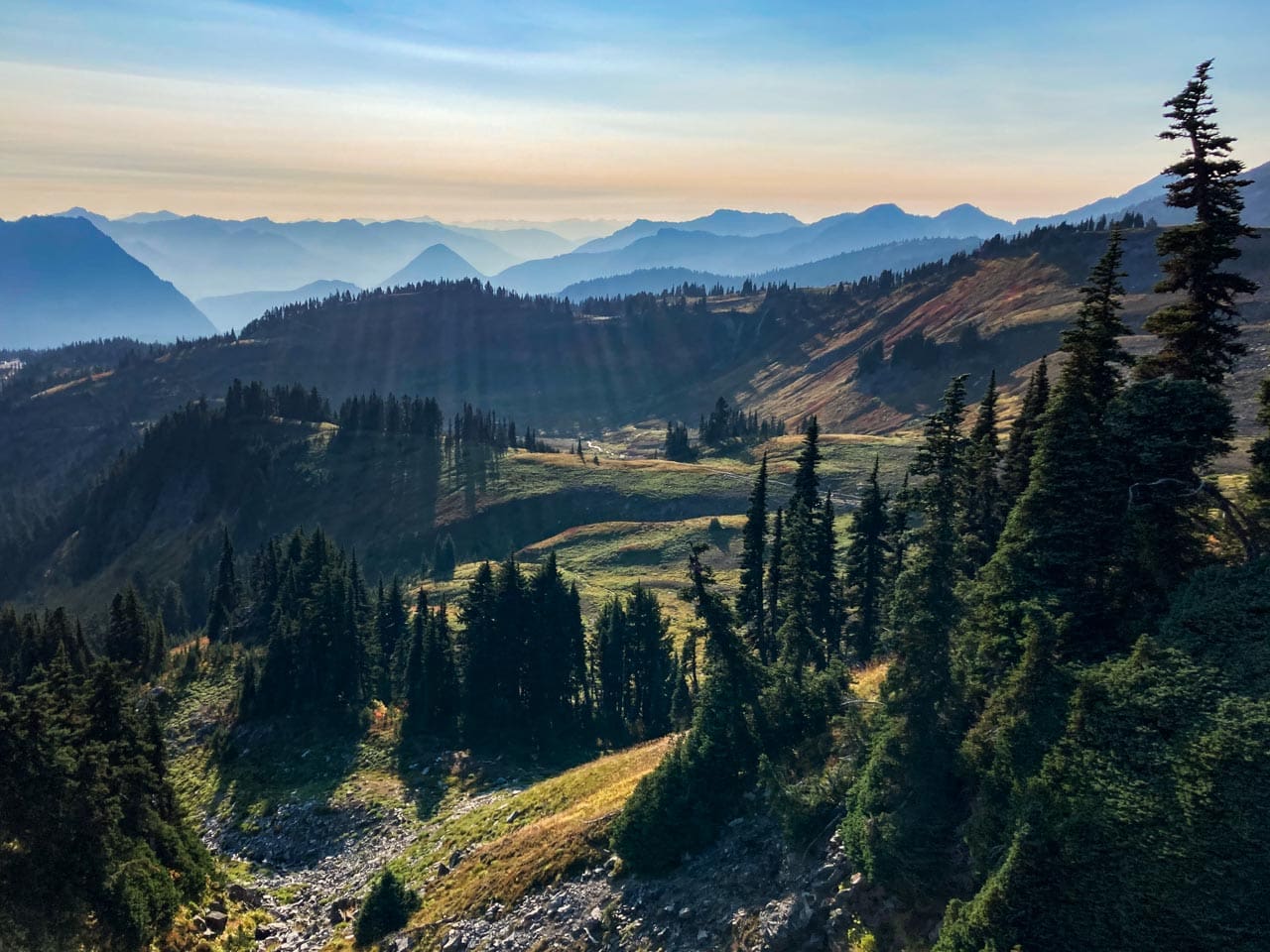
This blog post about what to do at Paradise in Mount Rainier National Park contains affiliate links. You can read more about our Terms of Use / Disclosure here.
Contents
- 12 Best Things to Do at Paradise (Mount Rainier National Park)
- Explore the Henry M Jackson Memorial Visitor Center
- See the Famous John Muir Quote on the Paradise Steps
- Visit the Historic Paradise Inn
- Stroll Across Subalpine Meadows Filled With Wildflowers
- Enjoy Amazing Up-Close Views of Mount Rainier
- Hike the Spectacular Skyline Trail
- Admire the Postcard-Perfect View of Myrtle Falls
- Walk the Nisqually Vista Trail
- Watch Marmots and Other Wildlife
- Drive the Paradise Valley Road
- View Mount Rainier’s Reflection in Reflection Lakes
- See a Rainbow at Narada Falls
- Winter Activities at Paradise, Mount Rainier National Park
- Visiting Mount Rainier National Park’s Paradise FAQs
- Where Is Paradise at Mount Rainier?
- How Did Paradise in Mount Rainier Get Its Name?
- How Many Days Do I Need to Explore Paradise?
- Is Mount Rainier’s Paradise Open Year-Round?
- What Is the Best Time to See the Paradise Wildflowers?
- Are Pets Allowed at Paradise in Mount Rainier National Park?
- Which Visitor Services Are Available at Paradise?
- More About Mount Rainier National Park
12 Best Things to Do at Paradise (Mount Rainier National Park)
“Paradise is famous for its glorious views and wildflower meadows,” the National Park Service says. It’s also one of Mount Rainier National Park’s most accessible areas, with a huge parking lot and many facilities and services available.
Several wonderful hiking trails wind their way through subalpine meadows, past viewpoints, and to waterfalls. Wildlife abounds at Paradise, too, including marmots, ground squirrels, pikas, deer, and black bears.
Architecture enthusiasts will love seeing and visiting the historic Paradise Inn, while casual day visitors enjoy picnics and short strolls, accompanied by incredible views of mighty Mount Rainier itself.
Let’s now take a closer look at the very best things to do at Paradise in Mount Rainier National Park.
Explore the Henry M Jackson Memorial Visitor Center
The Henry M Jackson Memorial Visitor Center at Paradise offers visitors all kinds of park information.
There are guided ranger programs, exhibits, the park film, a book and gift shop, and a deli. It also provides some of the best and most accessible views of Mount Rainier.
The visitor center is the starting point for hikes to popular places like Panorama Point, Myrtle Falls, Nisqually Vista, and around the glorious Paradise meadows.
See the opening seasons and times of the Henry M Jackson Memorial Visitor Center and other facilities here.
See the Famous John Muir Quote on the Paradise Steps
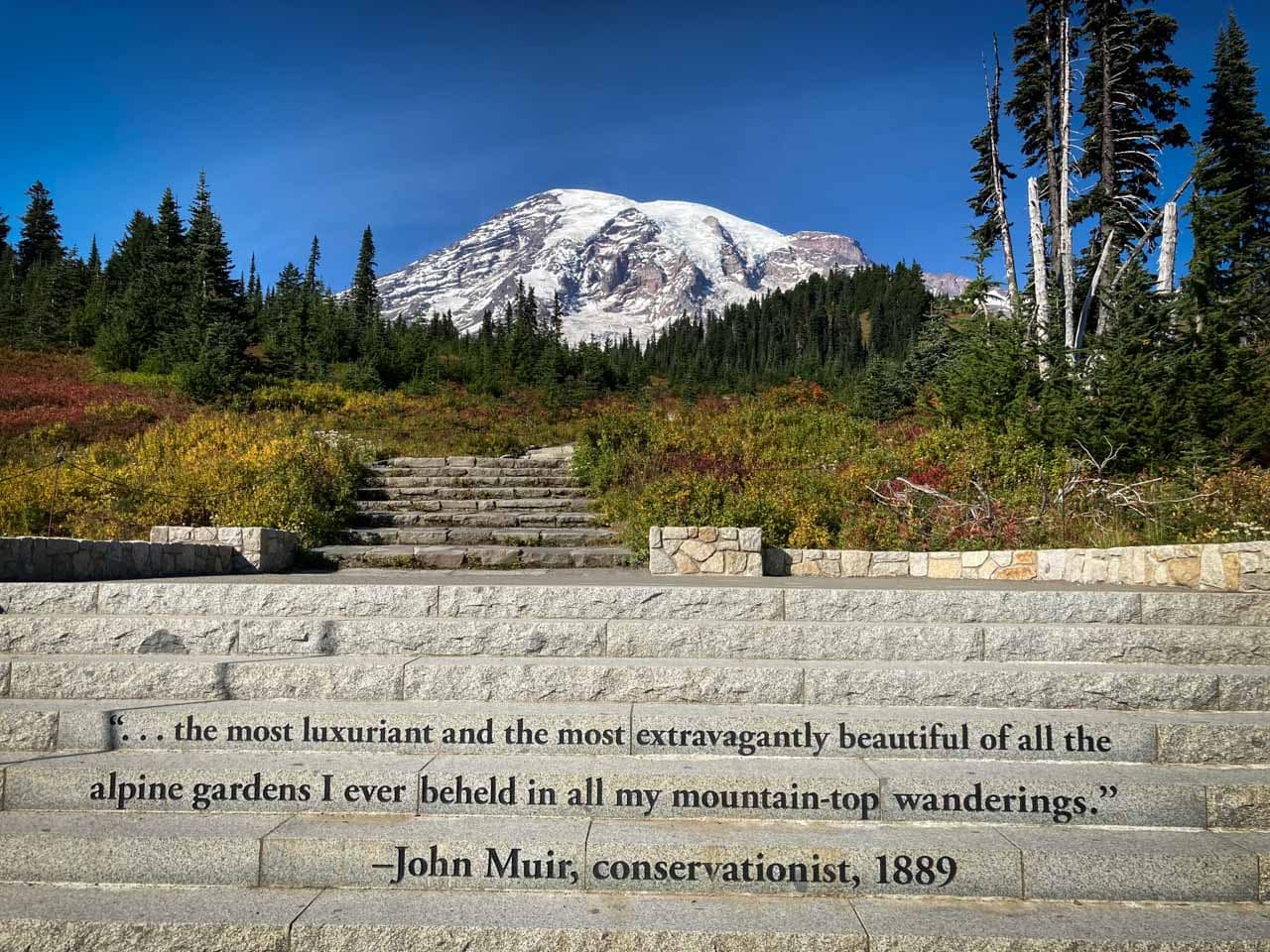
The iconic view from behind the visitor center takes in the famous steps with their iconic John Muir quote inscription, while Mount Rainier dominates the backdrop.
Upon his visit to Paradise in 1886, the legendary conservationist John Muir called these “the most luxuriant and the most extravagantly beautiful of all the alpine gardens I ever beheld in all my mountain-top wanderings.” And that’s an endorsement that truly means something.
These steps mark the start of the epic Skyline Trail, as well as shorter trails through the Paradise meadows, such as the Waterfall Trail, Avalanche Lily Trail, and Alta Vista Trail.
Visit the Historic Paradise Inn
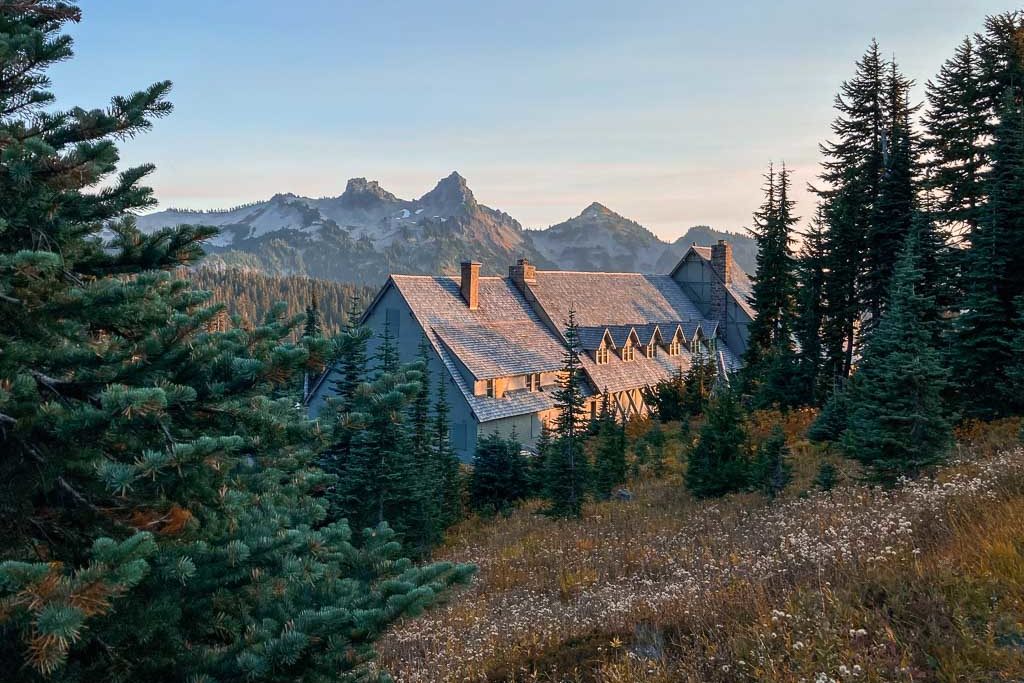
Inarguably the premier accommodation in Mount Rainier National Park, the historic Paradise Inn is one of the greatest examples of “National Park Service rustic”, also known as “parkitecture.”
Designed to blend in with its environment, the shapes of the Paradise Inn reflect the sharp peaks of the Tatoosh Range, while massive Mount Rainier towers above.
Additionally, observant of the native-materials policy of the parkitecture style, the hotel was built partially with the remains of a forest fire.
This magnificent national park hotel dates from 1916—it opened to the public in 1917—and has managed to keep its rustic charm and historic appeal throughout the decades.
It’s famous for being one of the “Great Lodges of the West.” Spending a couple of nights there is an unforgettable national park experience, but you can also just walk in and enjoy the rustic ambiance of its magnificent interior.
Nowadays, the Paradise Inn is at the heart of Mount Rainier National Park’s busiest area, which is, of course, Paradise. A sprawling parking lot accommodates the vehicles of hundreds of day visitors, while the nearby Henry M Jackson Memorial Visitor Center offers all kinds of information.
Additionally, you’ll also find a gift shop and bookstore, cafeteria, post office, restaurant, and ranger station in and around the Paradise Inn.
Typically open between mid-May and early-October, the Paradise Inn has 121 guestrooms.
Without modern amenities like WiFi, telephones or TVs, these charming historic rooms “invite our guests to imagine a time past when life was simple”, according to Rainier Guest Services, the inn’s concessionaire.
Stroll Across Subalpine Meadows Filled With Wildflowers
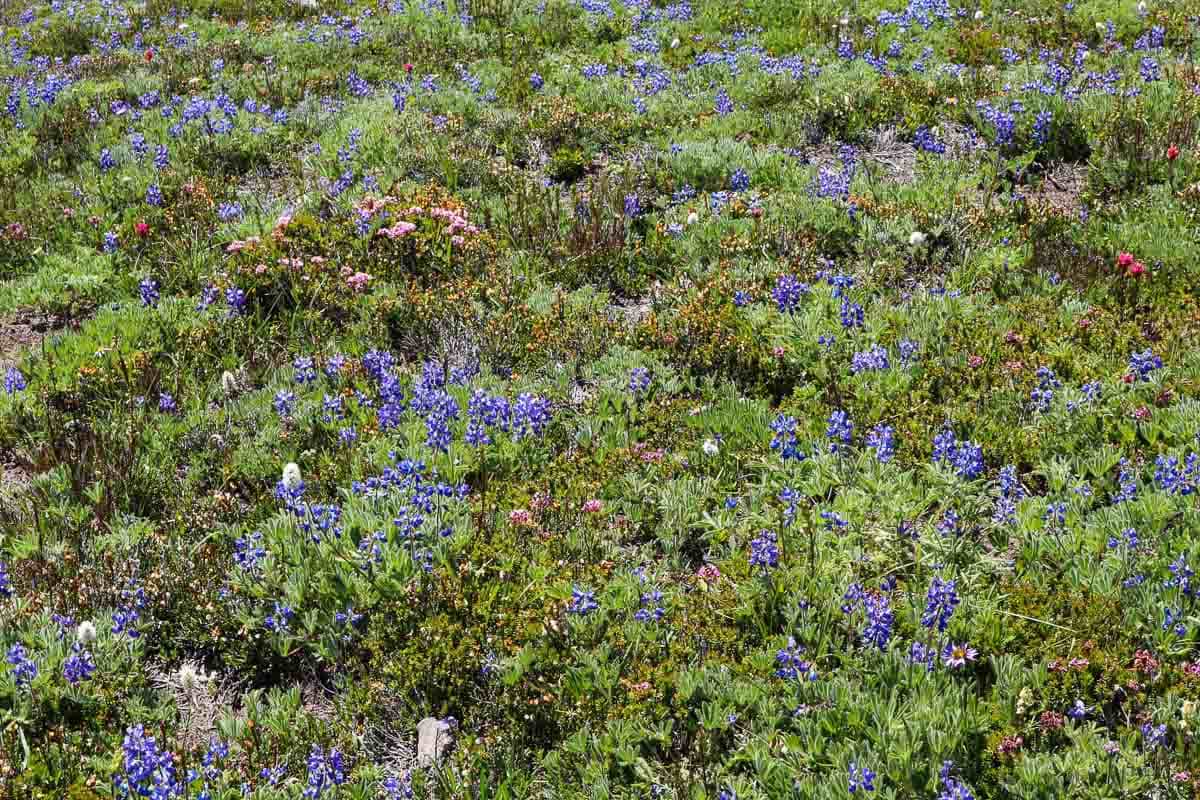
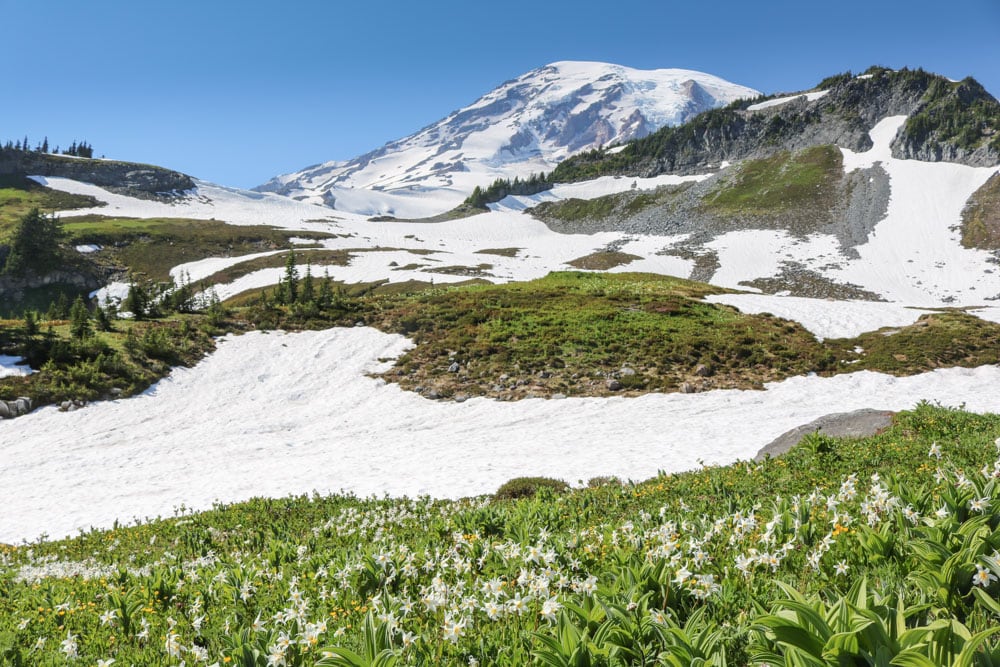
From mid-July through August, a kaleidoscope of wildflowers cover the slopes, ridges, and valleys of Mount Rainier National Park. Once you lay eyes on this amazing natural spectacle, you’ll realize why this is one of the best national parks to see wildflowers.
You’ll be able to see the Mount Rainier flowers throughout the entire park, including places like Sunrise and Tipsoo Lake, but few places compare to the subalpine meadows at Paradise.
The many intersecting hiking trails at Paradise give you the opportunity to create your own walks and enjoy the stunning Mount Rainier flowers at your own pace.
Looking for a long day hike? Hit the phenomenal Skyline Trail (see below), one of the best day hikes in the National Park System.
For shorter walks through the meadows—stay on the trail, though, and don’t pick any flowers!—consider the Nisqually Vista Trail, Alta Vista Trail, or Golden Gate Trail beyond Myrtle Falls.
The shortest wildflower hikes at Paradise are the Waterfall Trail and Avalanche Lily Trail.
All these trails start in the upper Paradise parking lot area, near the Paradise Inn or Henry M Jackson Memorial Visitor Center. Pick up a detailed trail map at the visitor center.
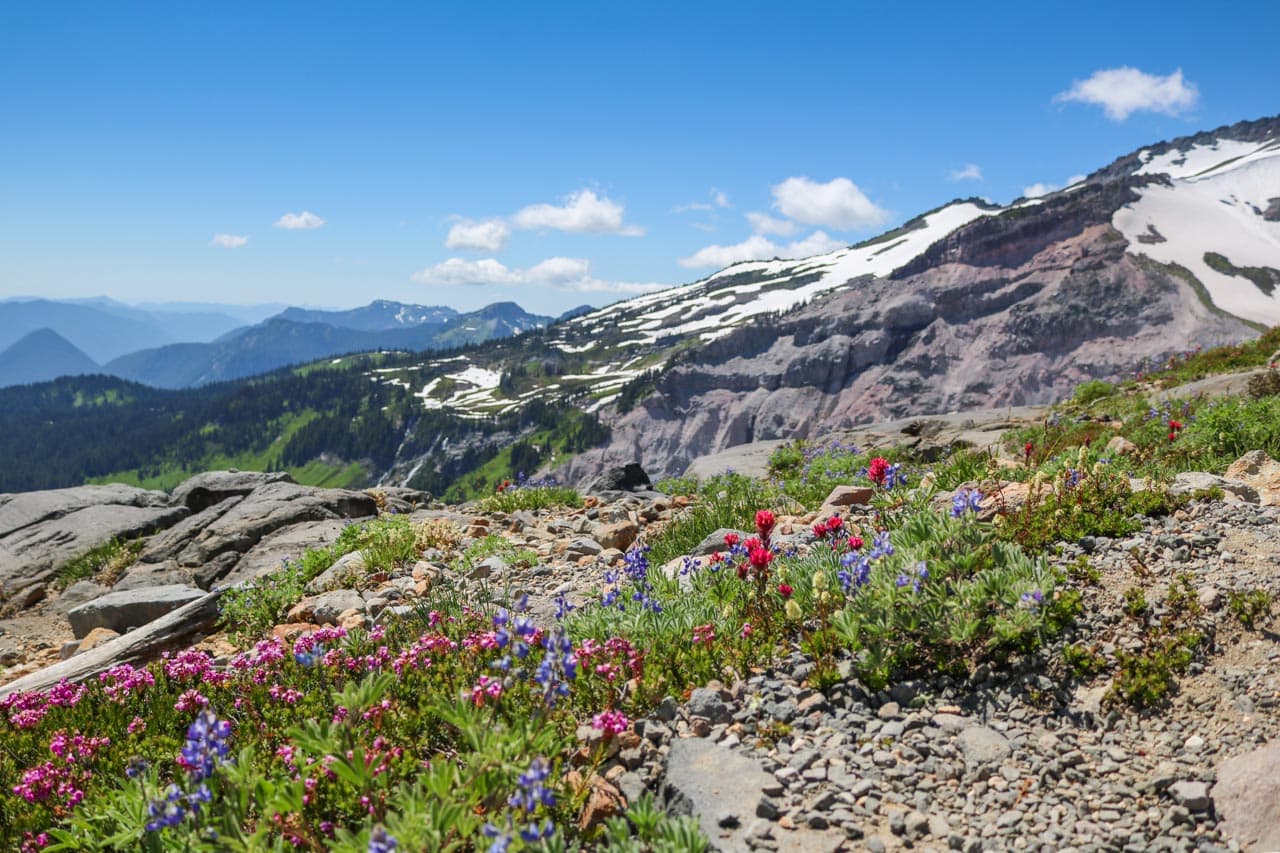
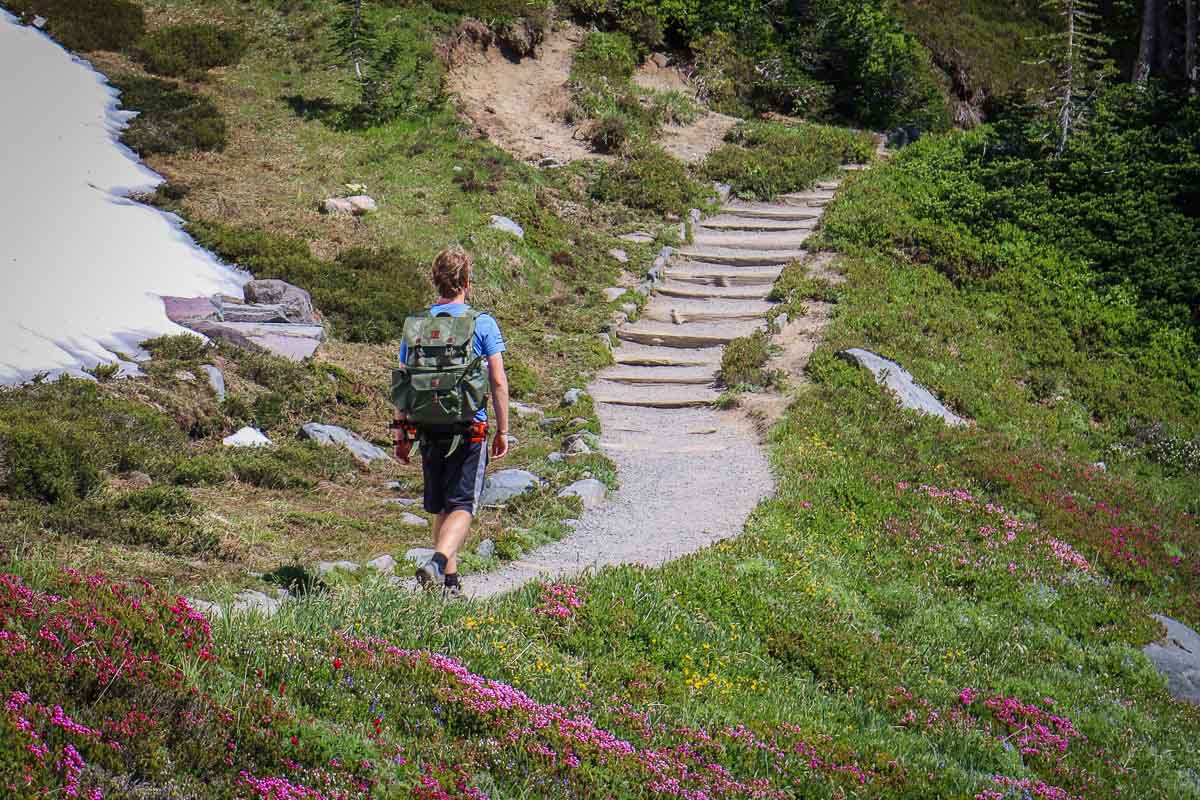
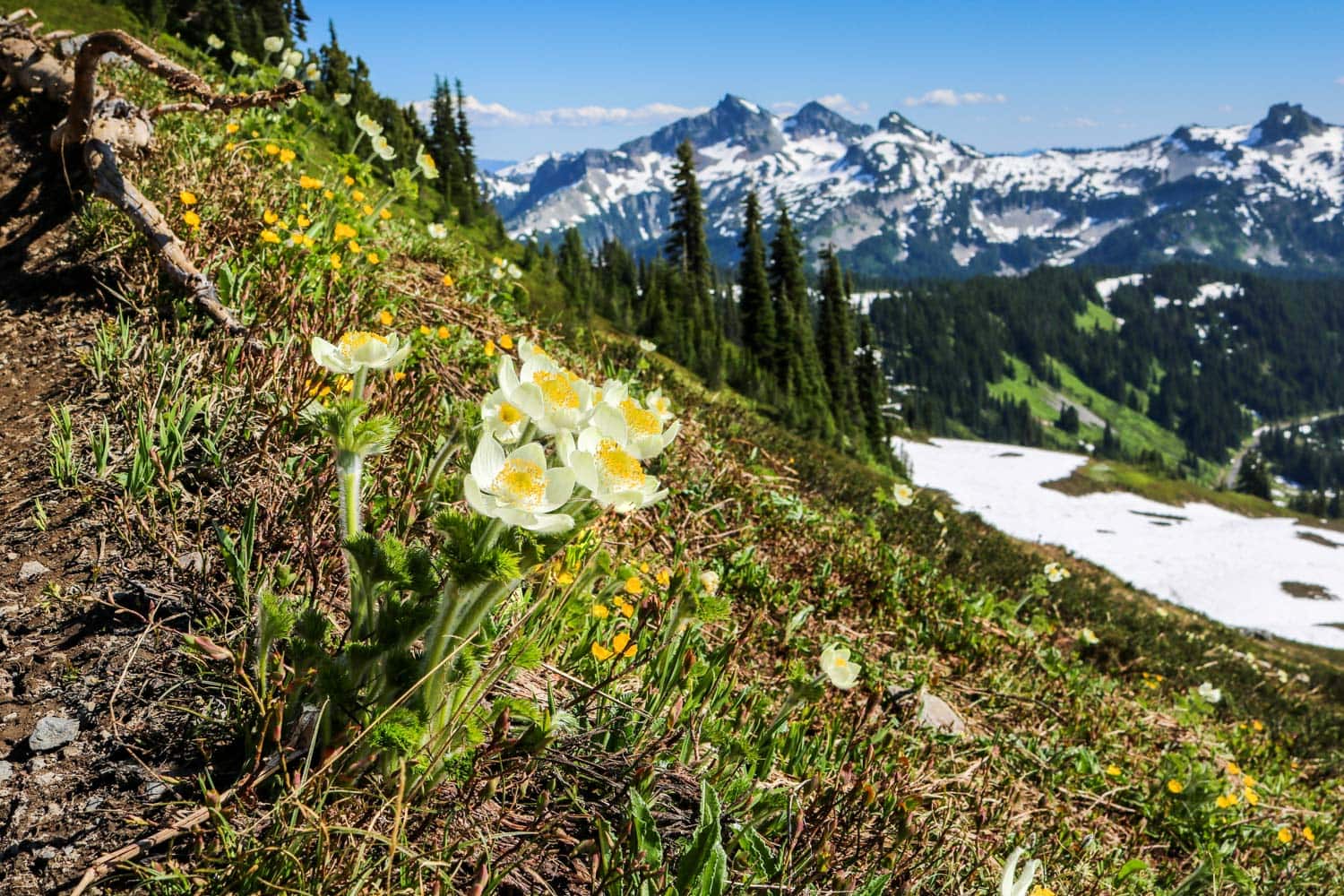
Subalpine Flowers in the Paradise Meadows
“Subalpine meadows or ‘parkland’ wreath the higher elevations of Mount Rainier, from about 4,500 to 6,500 feet,” the National Park Service says.
“This region is sometimes called subalpine parkland because at those elevations trees start thin out and grow in patches interspersed among meadow instead of continuous forest.”
Paradise, located at an elevation of 5,400 feet, is therefore right in the middle the park’s subalpine zone. One of the main reasons that its meadows have such impressive wildflower displays is that the growing season is really short.
Because snow can linger in the Paradise meadows well into June and sometimes even July, the flowers have to “bloom profusely in order to reproduce as quickly as possible before the winter snows return,” according to the Park Service.
This results in a brief but incredible burst of blooming wildflowers, literally hundreds of different species.
Look for flowers like alpine asters, beargrass, magenta paintbrush, glacier lilies, avalanche lilies, subalpine daisies, pasqueflowers, shrubby cinquefoils, and dwarf lupines.
SEE THE BEST WILDFLOWER HIKES AT MOUNT RAINIER HERE!
Enjoy Amazing Up-Close Views of Mount Rainier
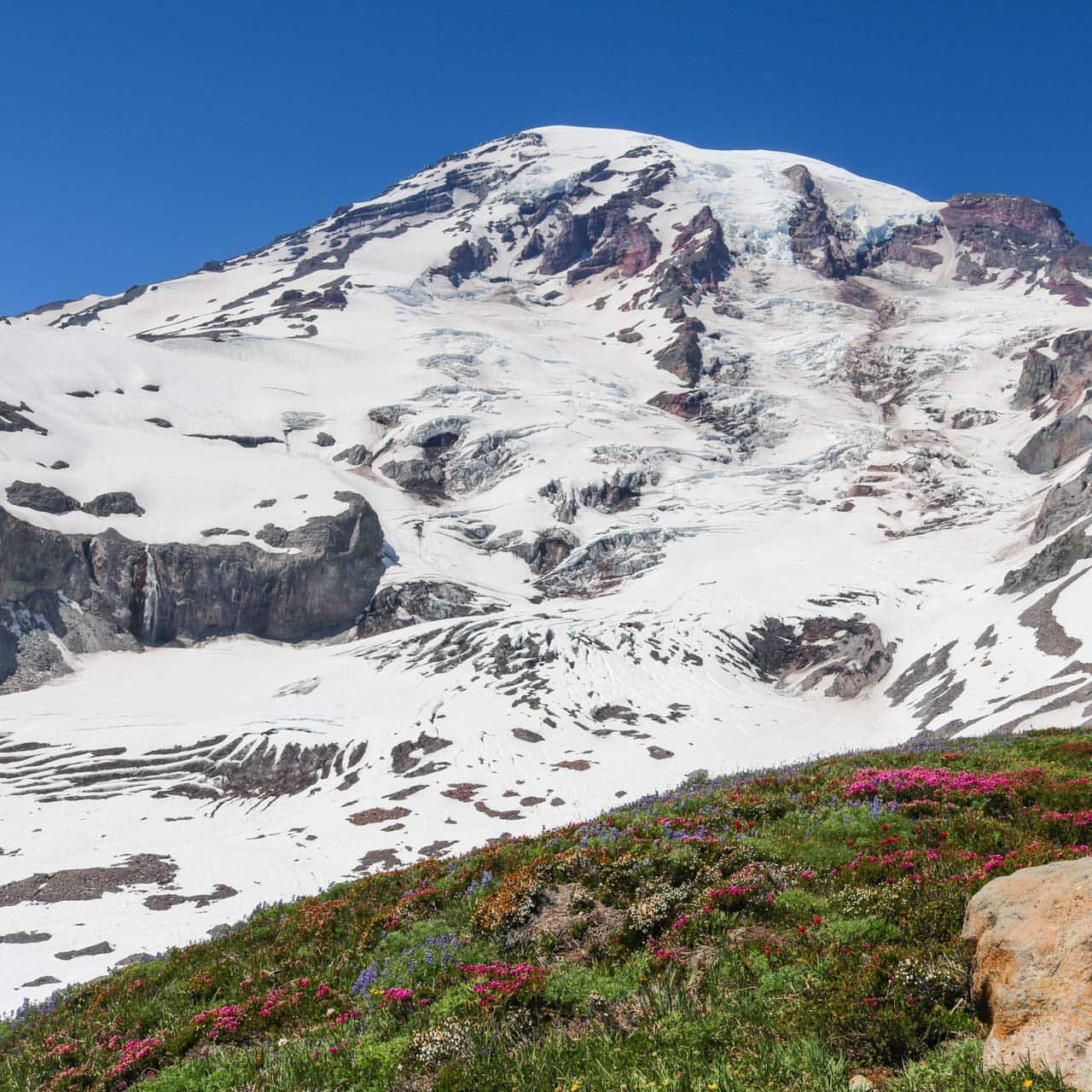
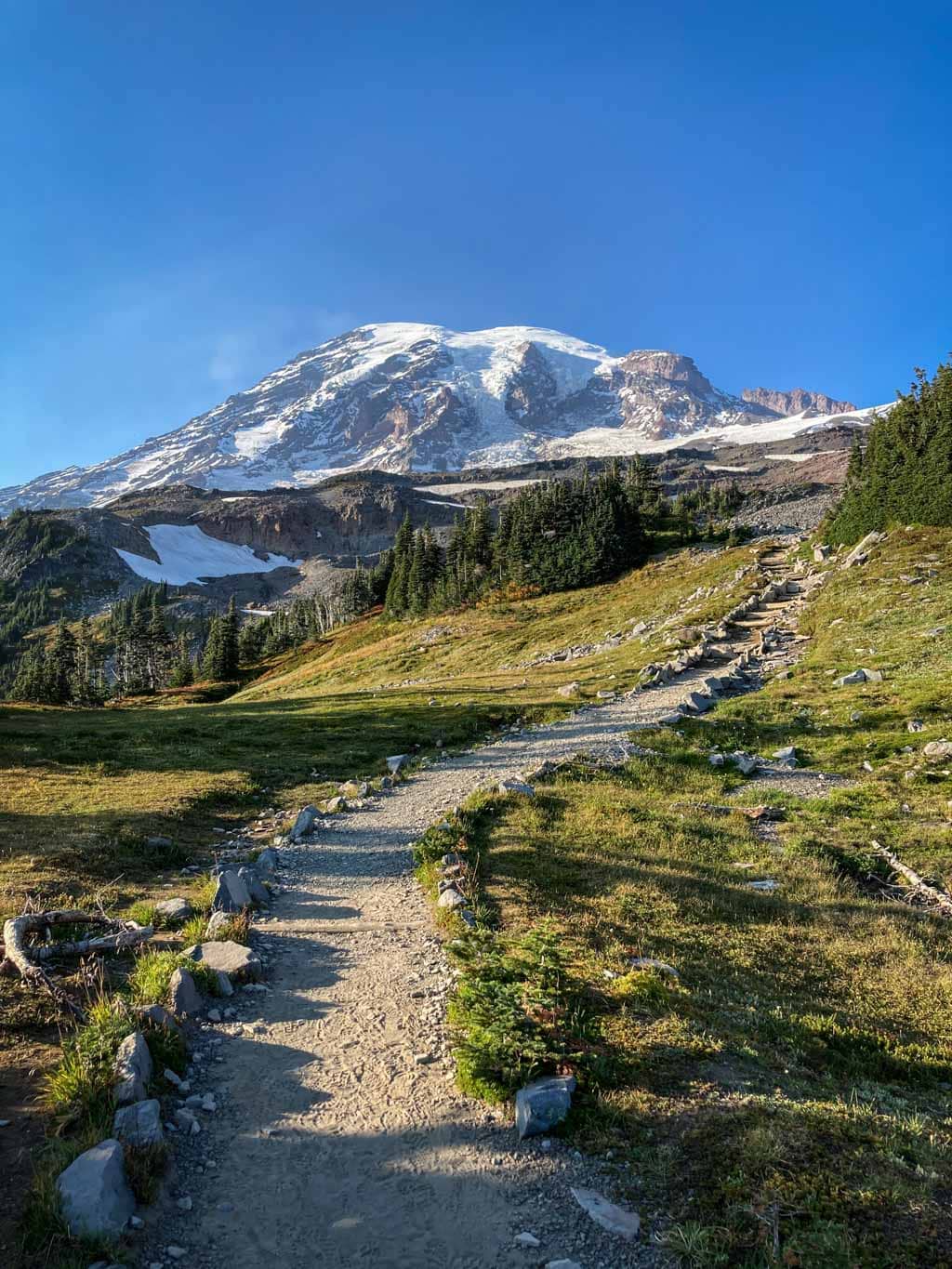
Sweeping views of Mount Rainier can be found throughout the entire Paradise area. At Paradise, seeing Mount Rainier up-close is a bonus that comes with virtually every other activity.
While hiking the area’s trails, picnicking, enjoying wildflowers, looking for wildlife, even walking to and from your car in the parking lot,… Mount Rainier is always right by your side.
For the absolute best views of this massive glacier-covered volcano, I recommend the following places:
- Henry M Jackson Memorial Visitor Center
- Upper part of the Skyline Trail
- Myrtle Falls and Edith Creek Basin
- Nisqually Vista Trail
- Reflection Lakes
Hike the Spectacular Skyline Trail
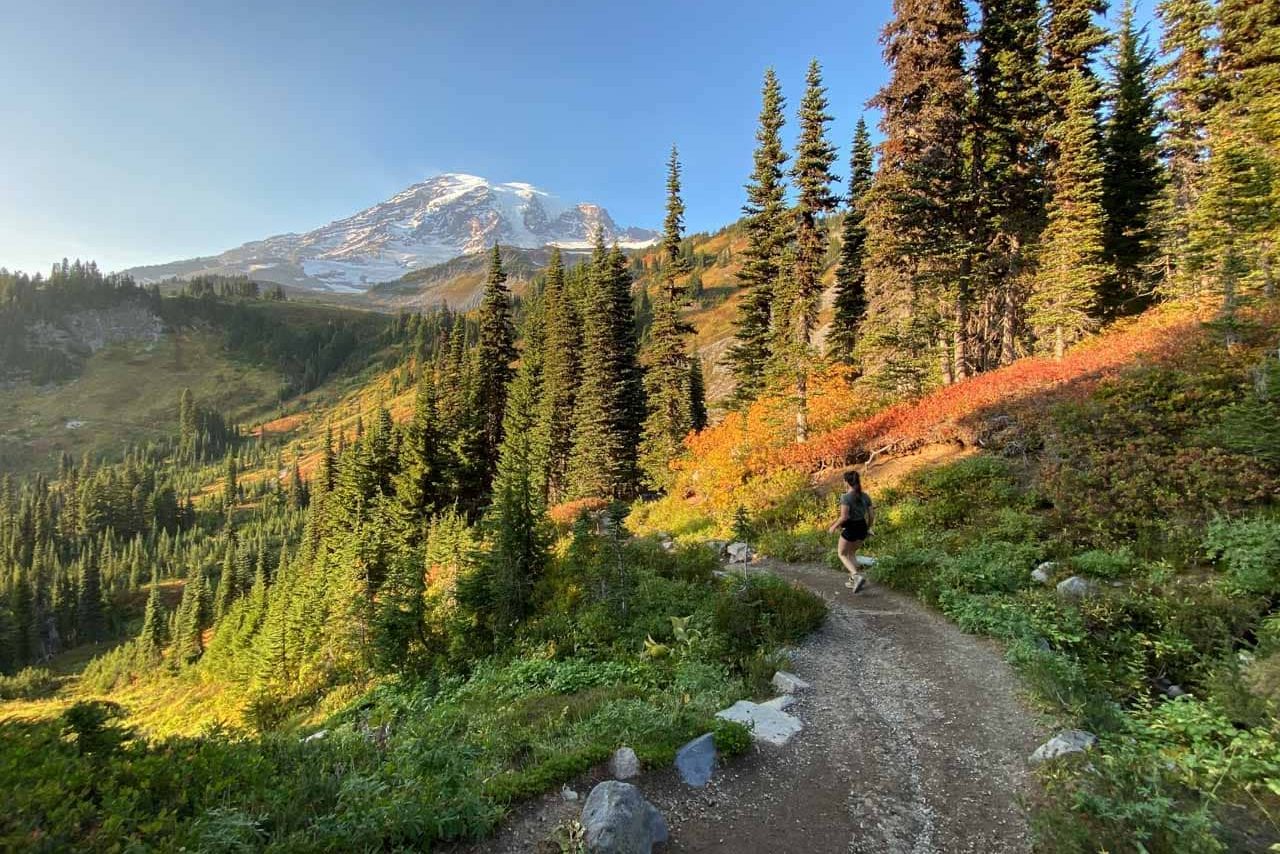
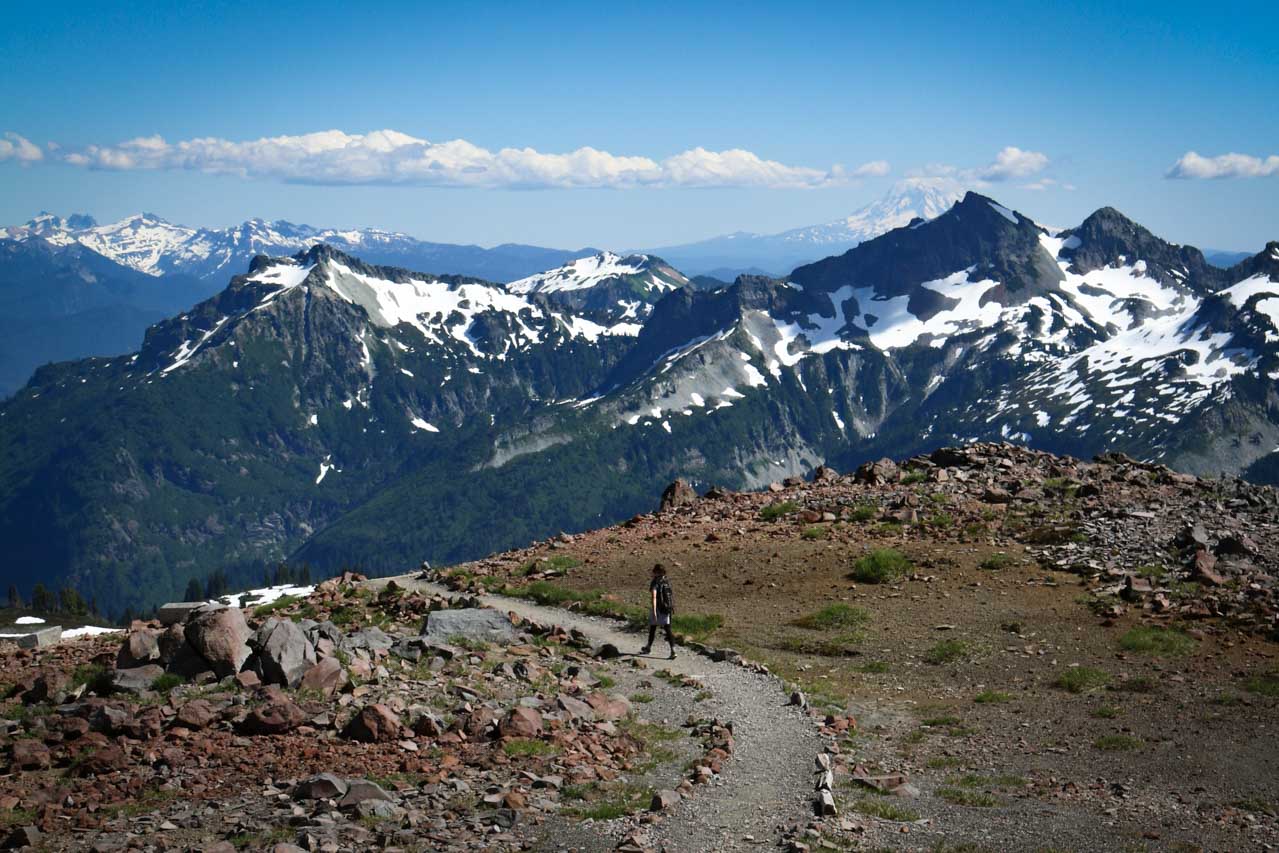
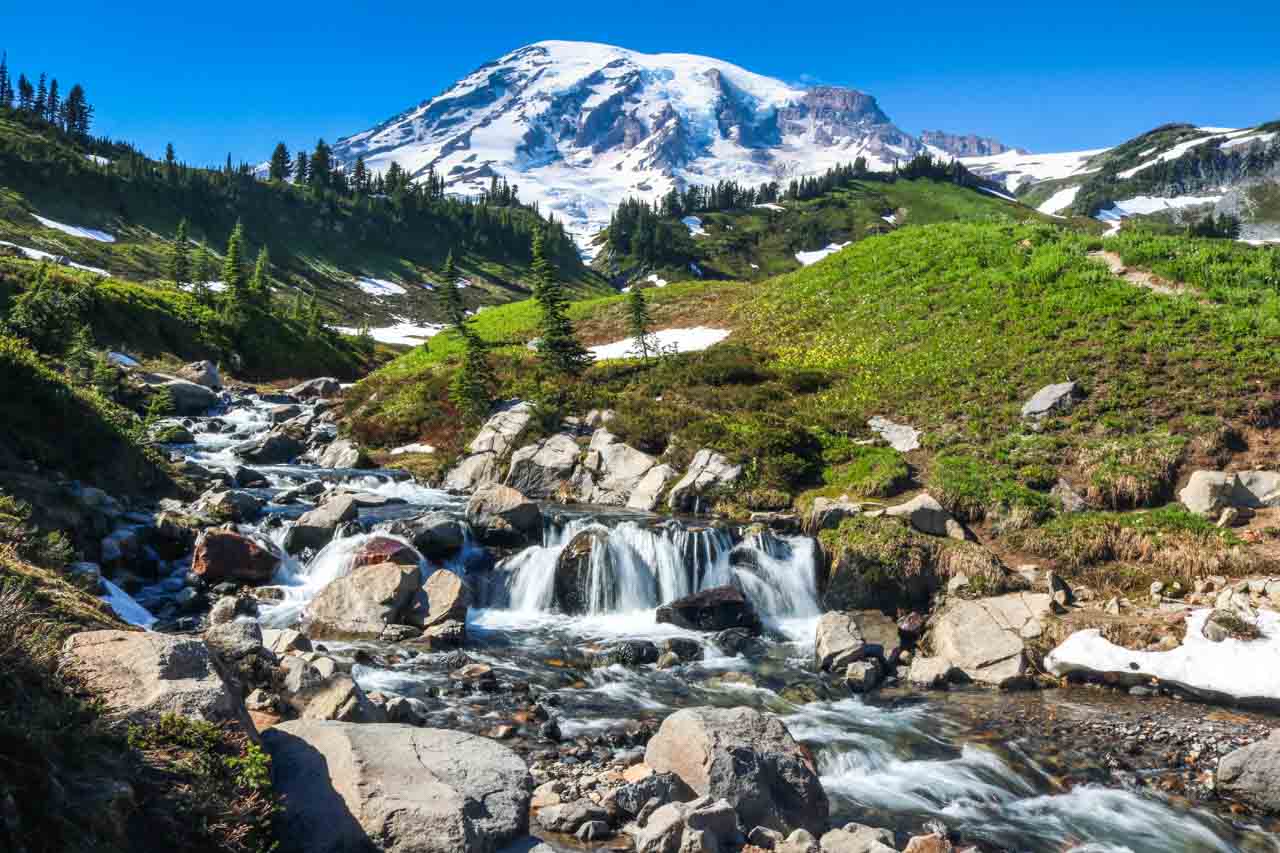
Without question one of the top things to do at Paradise, the Skyline Trail is nothing short of epic. It’s by far my favorite hike in Mount Rainier National Park and I hike it every time I visit the park.
This 5.5-mile roundtrip hike starts at the Visitor Center at Paradise, just behind the Paradise Inn, climbing 1,700 feet to well above the tree line.
As I’ve talked about above, you’ll walk through gorgeous subalpine meadows filled with all kinds of flowers.
(Additionally, this is also a great fall hike in Mount Rainier National Park. The bushes and shrubs in the meadows turn bright orange and red in late-September.)
Another major highlight on this hike is Panorama Point, which offers breathtaking panoramic views of the Cascade Range. The vista includes several other volcanoes, such as Mount Adams, Mount St. Helens, and even Mt. Hood all the way to the south.
As you loop around the upper Paradise area, you’ll get incredibly close to the mountain and the views of Mount Rainier are truly jaw-dropping here.
I recommend hiking the Skyline Trail in a clockwise direction, preferably a few hours before sunset. This way, you’ll save gorgeous Myrtle Falls for the end of your hike, one of the top attractions in the park and an amazing place to end this scenic day hike.
Admire the Postcard-Perfect View of Myrtle Falls
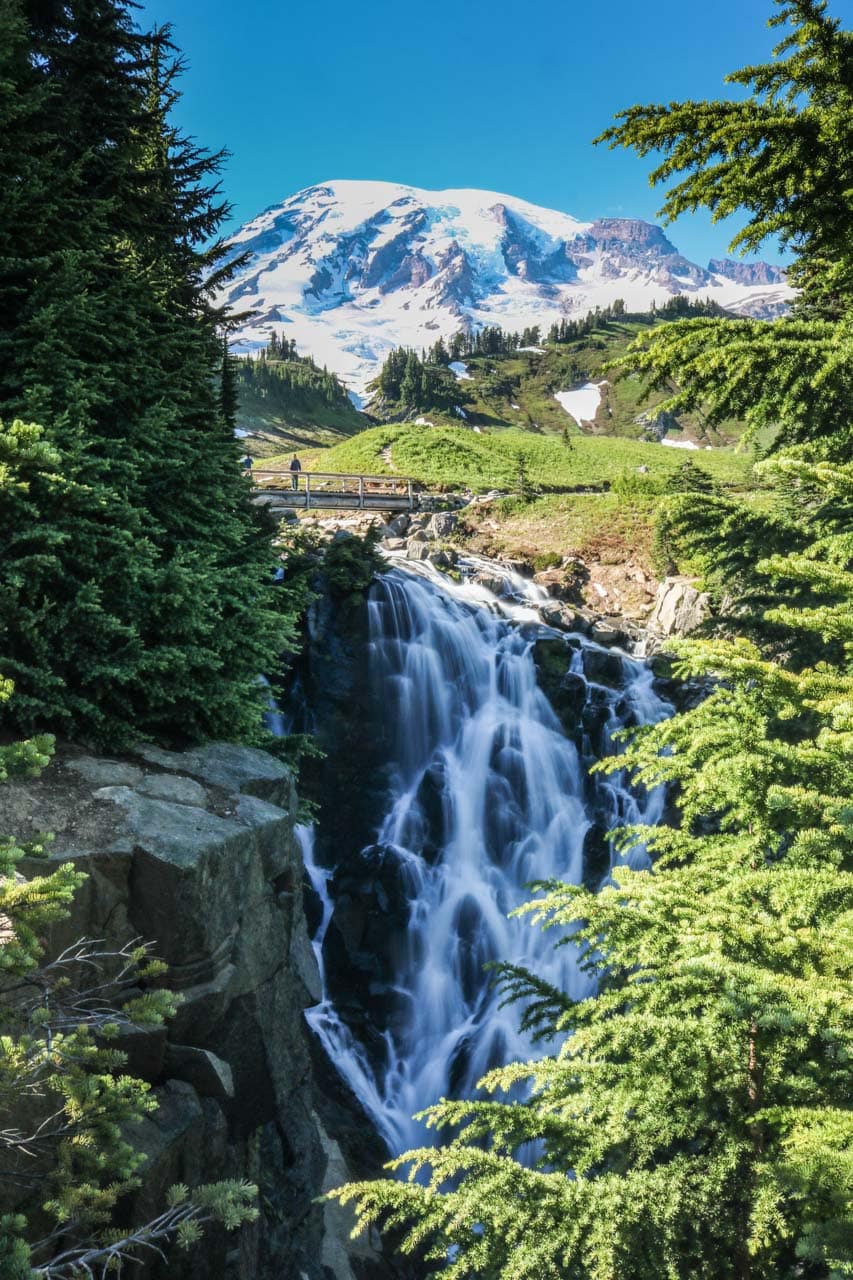
The absolute jewel in the brilliant crown of Mount Rainier scenery is Myrtle Falls. Even though the 60-foot height of this waterfall may not be spectacular, its setting undeniably is. It is absolutely breathtaking.
Situated about 0.5 miles from the Paradise Inn on a paved section of the Skyline Trail, this braided waterfall in Edith Creek is backed by majestic Mount Rainier itself.
Tall trees frame Myrtle Falls amazingly well, while the meadows of Paradise roll towards the mountain behind the falls.
A small wooden bridge crosses Edith Creek just above the falls, providing fantastic photo opportunities.
This incredible scene of rolling meadows, a roaring waterfall, and Mount Rainier itself makes the Skyline Trail one of the best waterfall hikes in the National Park System.
And if you’re just looking for easy hikes at Paradise in Mount Rainier National Park, Myrtle Falls really is as good as it gets.
In fact, this is easily one of the top attractions at Mount Rainier. If you only have time for one or two short hikes in the park, I strongly—strongly!—recommend you do this one.
As far as things to do at Paradise go, I could not recommend the walk to Myrtle Falls more. It’s an absolute must.
Walk the Nisqually Vista Trail
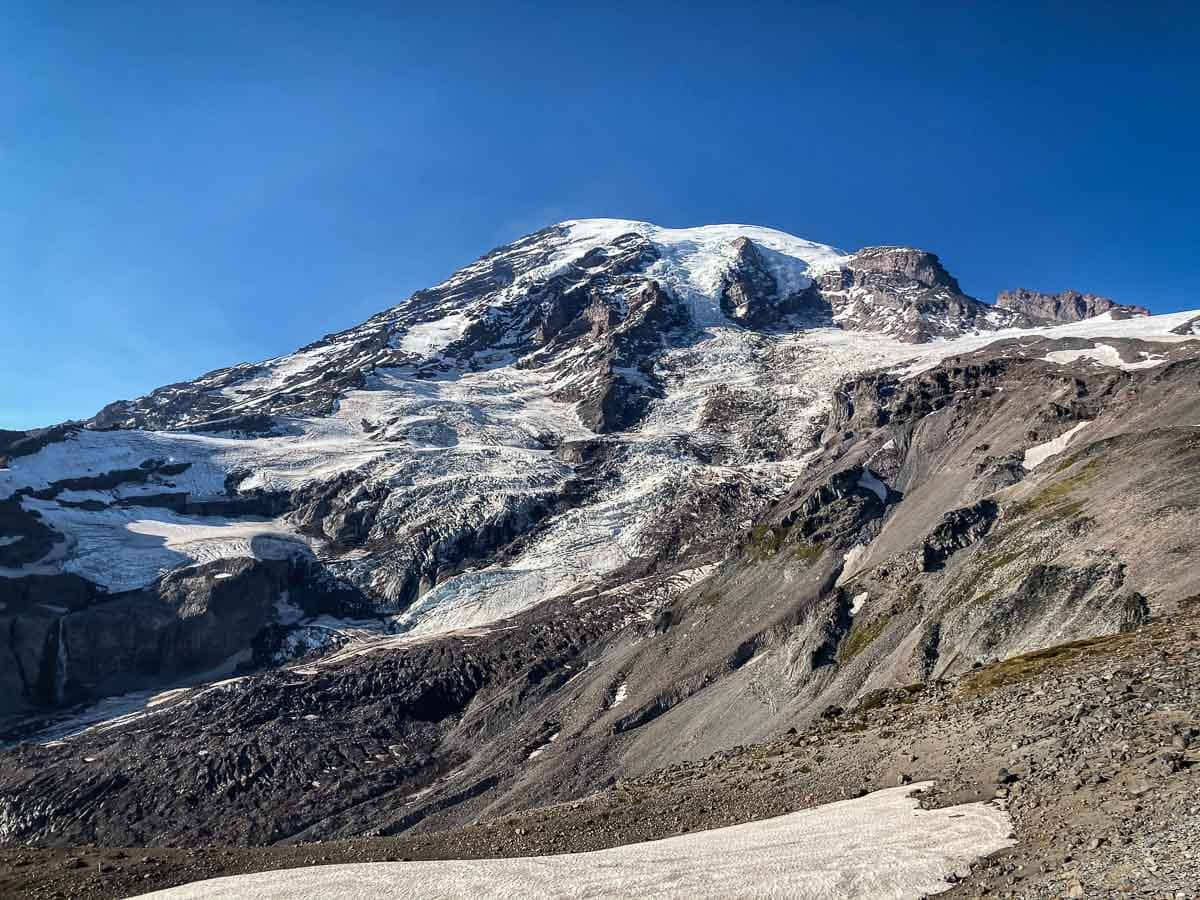
If you’re looking for the best easy hikes in Mount Rainier that offer both wildflowers and views of the mountain, I strongly recommend the Nisqually Vista Trail.
This easy 1.2-mile loop hike starts at the western end of the lower Paradise parking area and is suitable for families with strollers. Along the way, you’ll get to immerse yourself in gorgeous summer wildflowers or amazing fall foliage.
As you walk through the meadows of Paradise, you’ll always be accompanied by great views of Mount Rainier itself. The trail is named after the massive Nisqually Glacier, which is clearly visible on this easy hike in Paradise.
Additionally, if you’re lucky, you might also spot some wildlife here. Deer frequent the Paradise meadows and are common sights, as are smaller mammals like chipmunks, ground squirrels, and marmots. I’ve even seen a couple of black bears here!
Watch Marmots and Other Wildlife
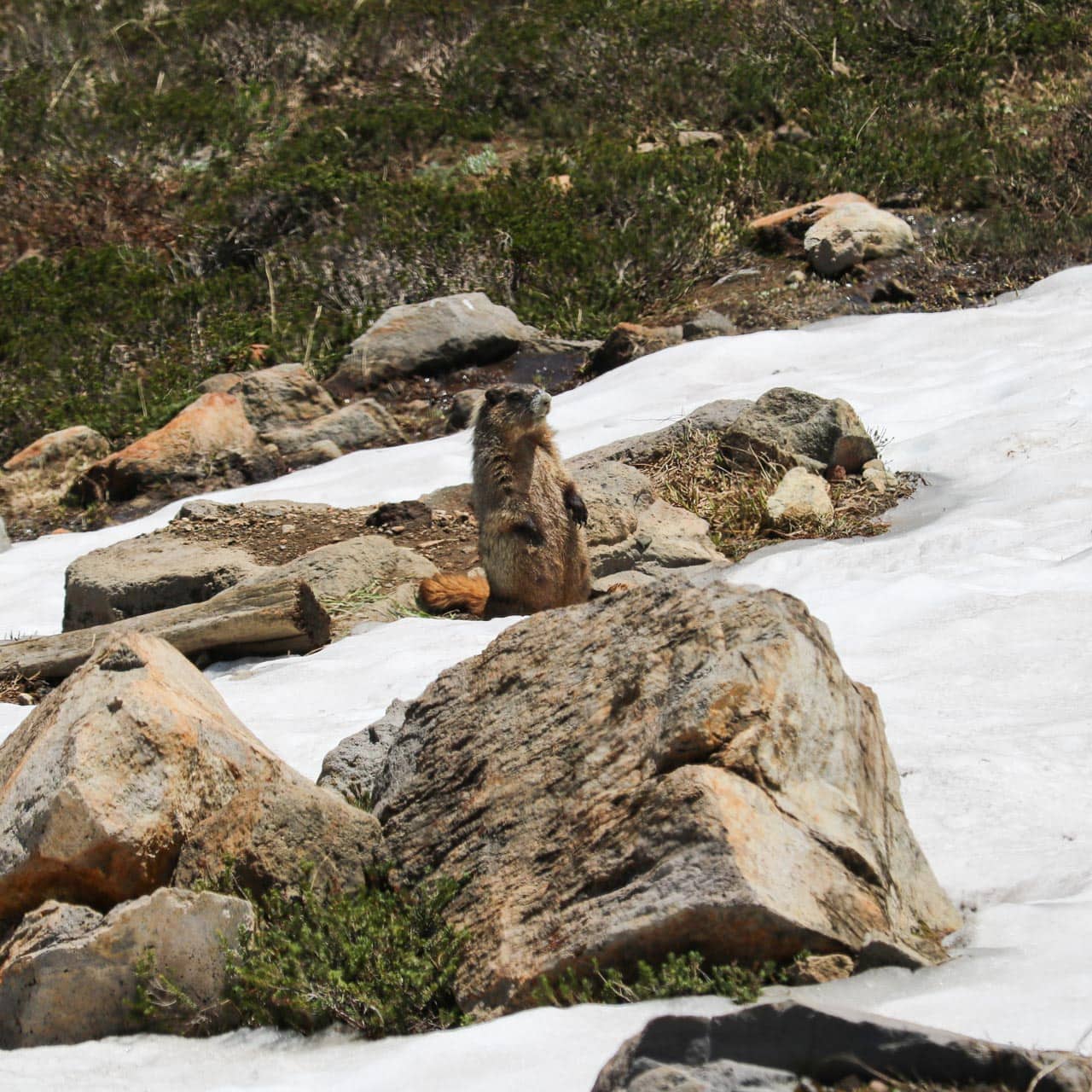
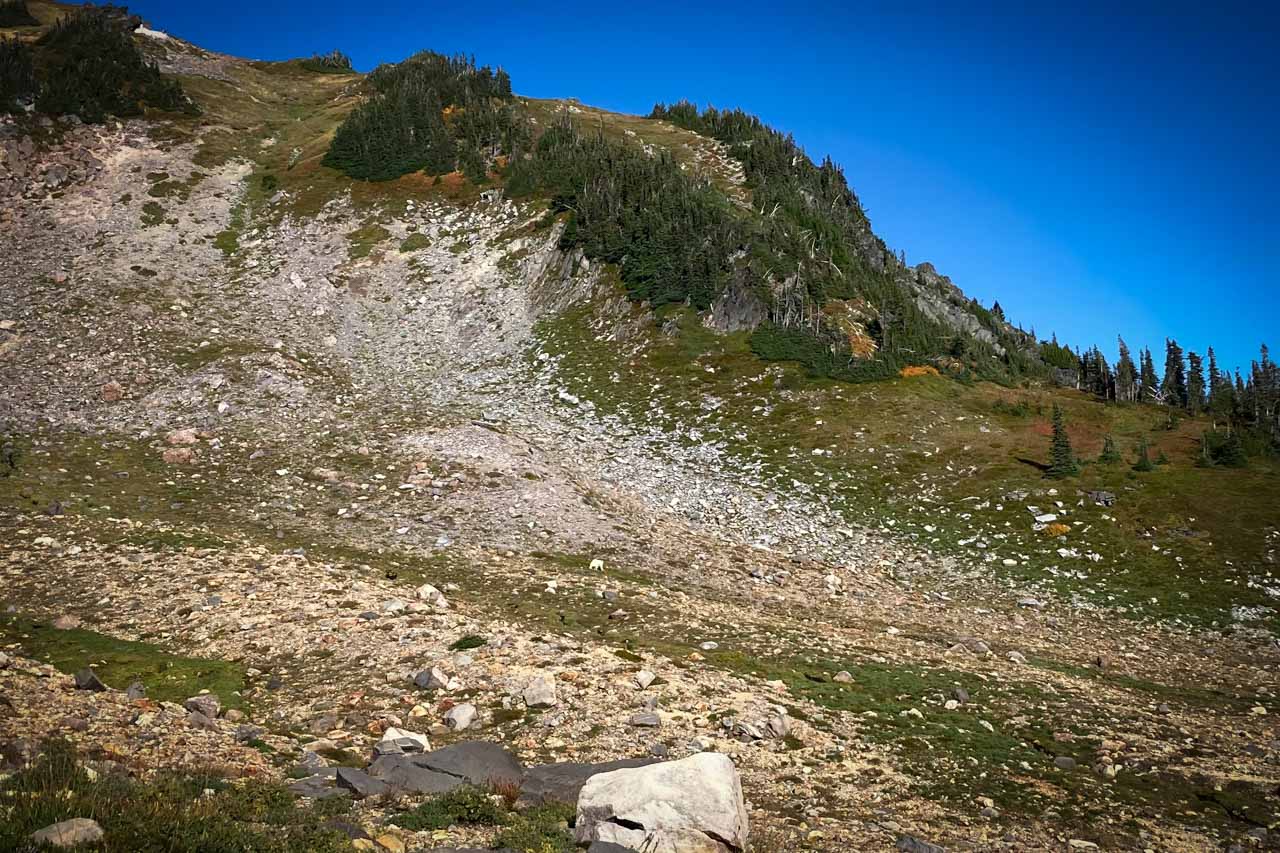
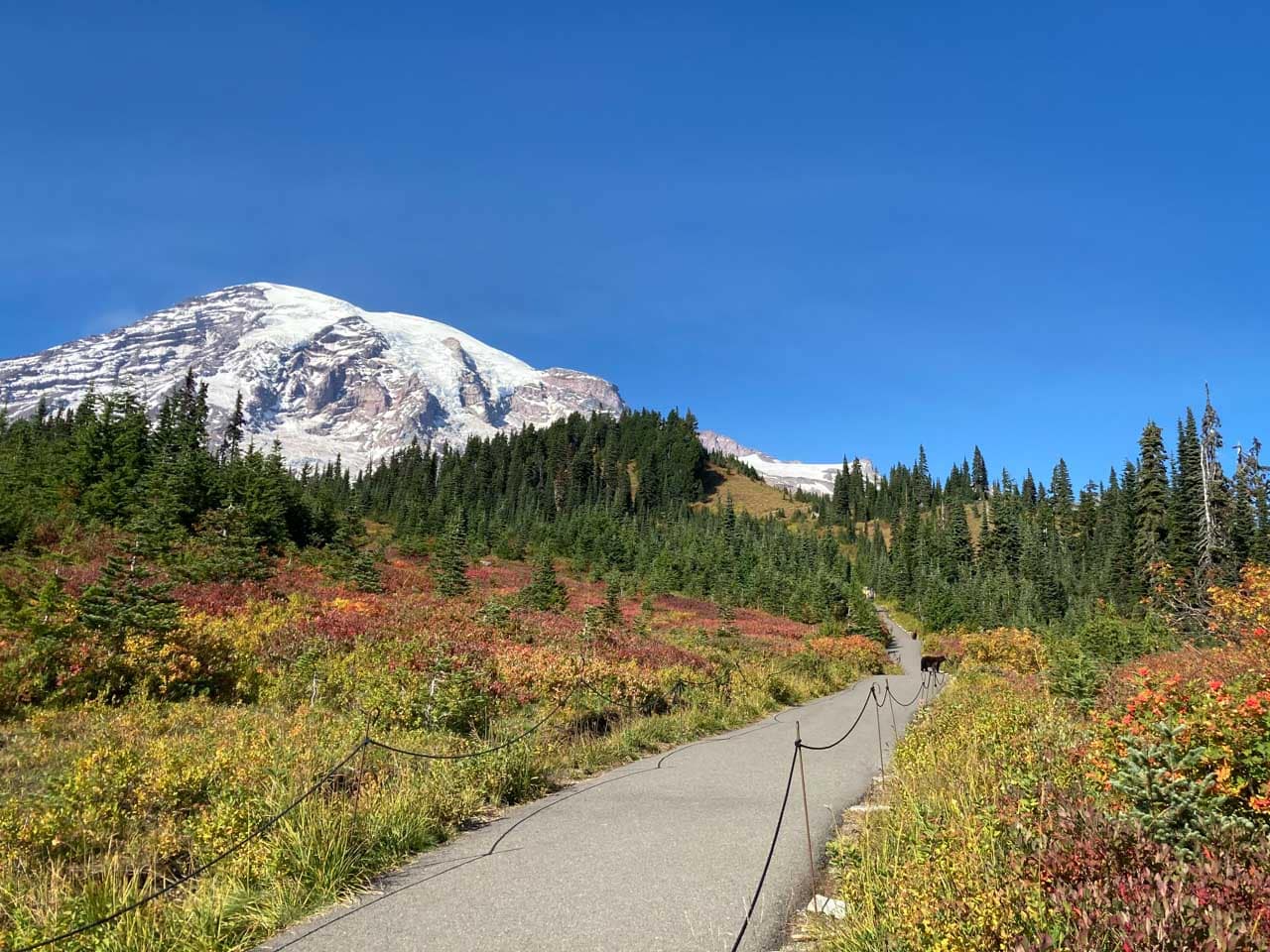
One of the most vocal animals in the subalpine meadows of Paradise, hoary marmots (Marmota caligata) are often heard “whistling” as they warn each other against potential threats.
These large rodents are also very visible, though, and you can usually see them along many of the area’s trails.
Other common wildlife at Paradise includes several other small mammals, such as golden-mantled ground squirrels (Callospermophilus saturatus), yellow pine chipmunks (Tamias amoenus), and the adorable American pikas (Ochotona princeps).
In summer, you might see some black-tailed deer (Odocileus hemionus columbianus) in the meadows, while mountain goats (Oreamnos americanus) are occasionally spotted on the higher slopes.
As far as carnivores are concerned, several species call the general Paradise area home. Few are commonly seen, though.
The only predators I’ve personally seen at Paradise are black bears (Ursus americanus), which are actually quite common along the Skyline Trail. If you’re lucky, however, you might also see a coyote (Canis latrans), bobcat (Lynx rufus), raccoon (Procyon lotor), or a rare Cascade red fox (Vulpes vulpes cascadensis).
See the full list of mammal species in Mount Rainier National Park here and learn about black bear safety here.
If you’d like to see birds at Paradise, there are numerous of those as well.
Look for avians as varied as golden eagles (Aquila chrysaetos), mountain bluebirds (Sialia currucoides), Steller’s jays (Cyanocitta stelleri), calliope hummingbirds (Selasphorus calliope), gray-crowned rosy finches (Leucosticte tephrocotis), and horned larks (Eremophila alpestris).
On the ground, keep your eyes peeled for white-tailed ptarmigans (Lagopus leucura) and sooty grouse (Dendragapus fuliginosus), which are sometimes called “the turkey of Mount Rainier National Park.”
See the full list of bird species in Mount Rainier National Park here.
Drive the Paradise Valley Road
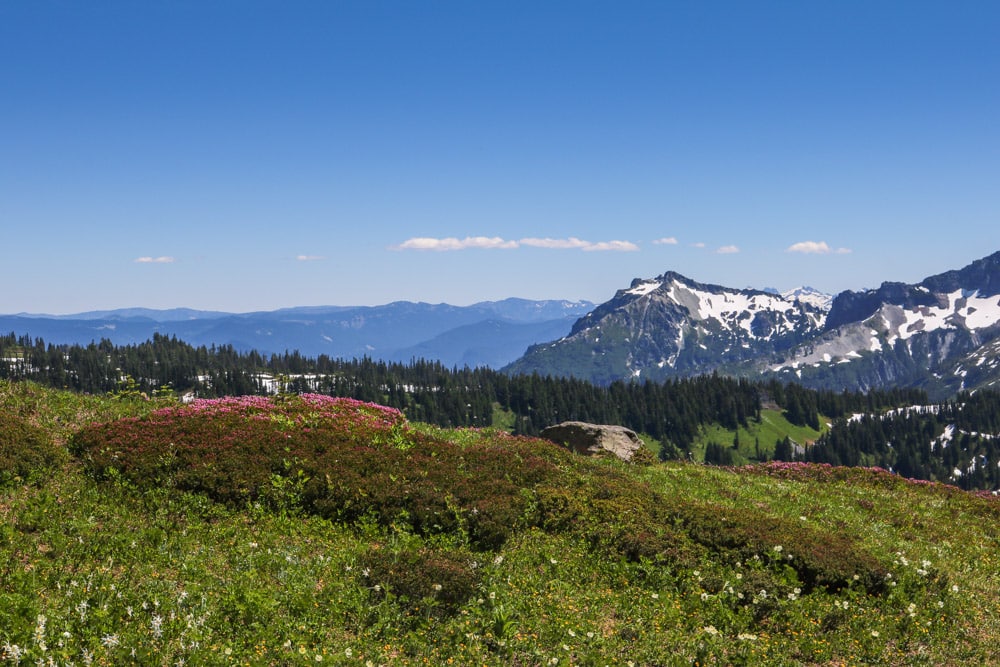
The Paradise Valley Road is a 2-mile one-way drive from the upper parking lot at Paradise to the intersection with the Stevens Canyon Road.
Along the way, you can admire more of the area’s spectacular subalpine meadows, beautiful forests, and views of the Tatoosh Range.
At the end of the Paradise Valley Road, you can loop back up to Paradise via the main two-way road or continue to other places in the park.
Turn left to go to Reflection Lakes and beyond to the Ohanapecosh area. Turn right to visit Narada Falls and drive to Longmire.
View Mount Rainier’s Reflection in Reflection Lakes
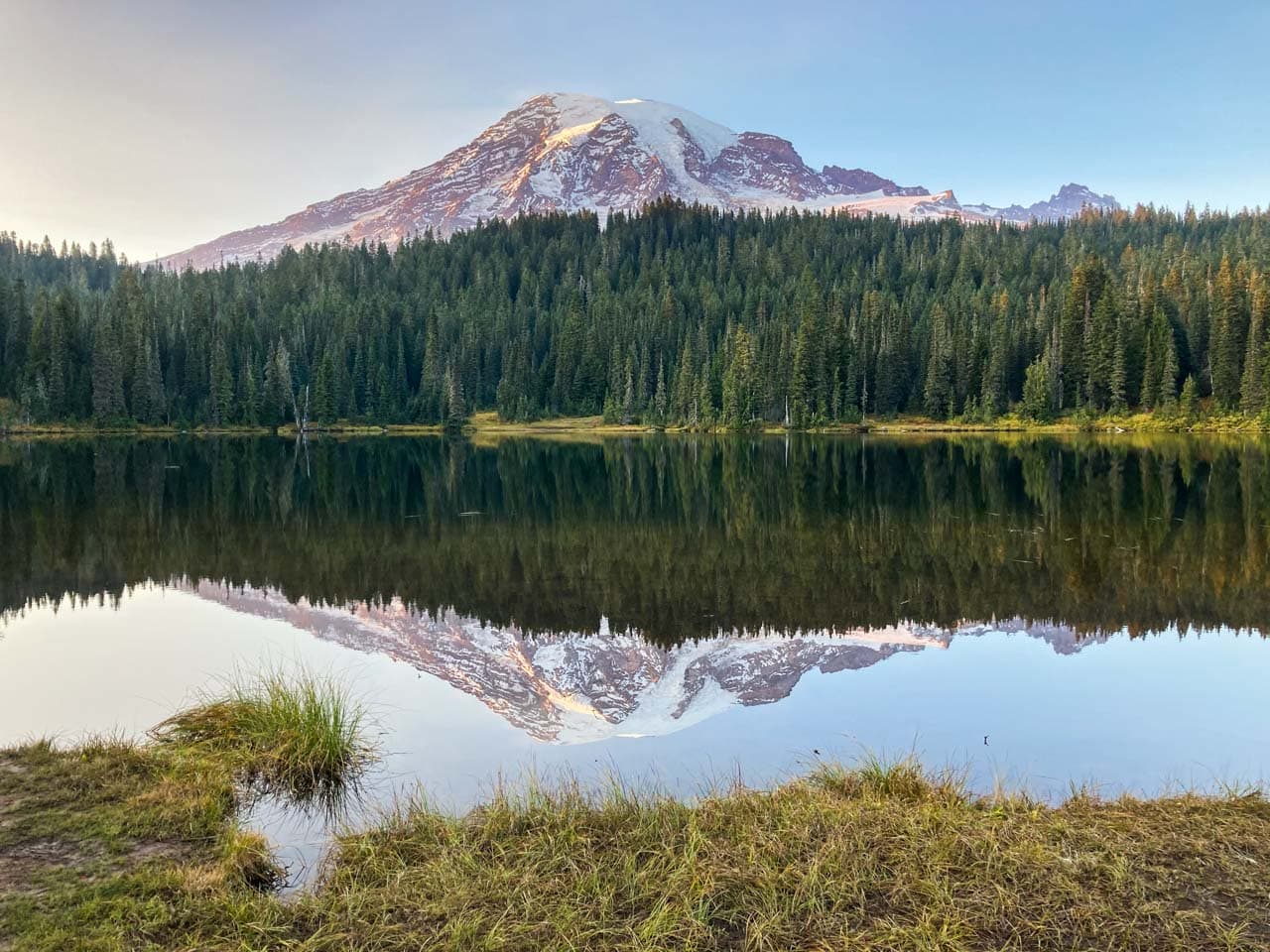
Located about 3 miles below Paradise on the Stevens Canyon Road, the popular Reflection Lakes offer some of the most famous views of Mount Rainier.
The best time to visit this beautiful location is either early in the morning or late in the evening. This is when the water usually is at its stillest, thus providing the nicest reflections of Mount Rainier.
You can simply park at one of the roadside parking lots and walk down to the water’s edge for prime photo ops.
If you’re up for a short hike, consider hiking the Reflection Lakes Loop. This 2.8-mile loop starts at the Reflection Lakes parking area and is best hiked in a clockwise direction. It’s a combination of the Wonderland Trail, the Lower Lakes Trail and the High Lakes Trail, as well as the Mazama Ridge Trail back down.
For a longer hike in the Paradise area, consider the moderately difficult 5-mile Lakes Trail Loop, a fantastic day hike that connects upper Paradise and the Reflection Lakes.
See a Rainbow at Narada Falls
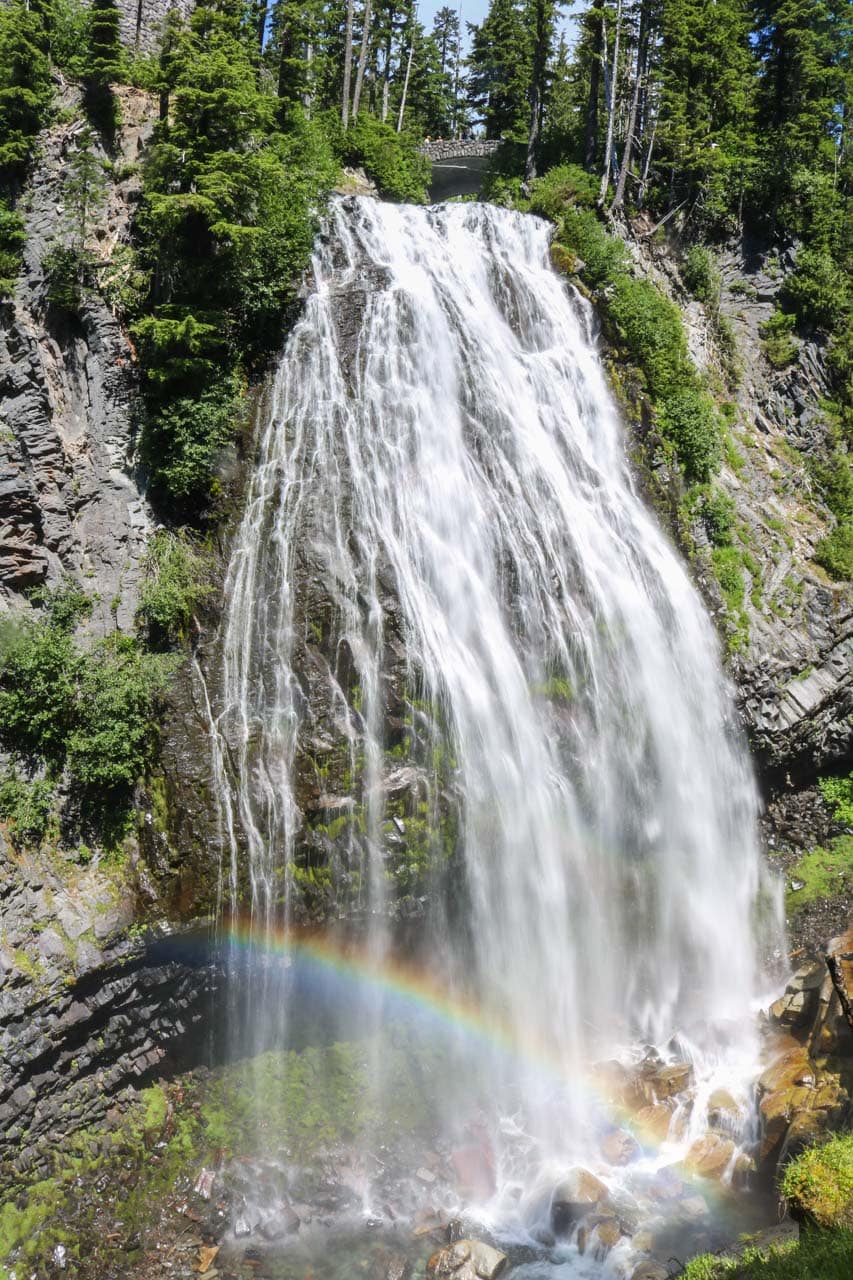
Easily one of the most beautiful waterfalls at Mount Rainier, Narada Falls is about 3 miles from Paradise.
On sunny days, the waterfall’s spray and mist often create a beautiful rainbow at its base. It pretty magical and easily one of the top sights in the Paradise area.
You can see Narada Falls from the top, but I highly recommend walking the steep but short path to the bottom of the falls, where you can enjoy an unobstructed view of the entire 168-foot waterfall.
If it’s a rainy day, be careful on this steep trail—it can be slippery when wet.
Alternatively, you can also hike down to Narada Falls from the upper Paradise parking lot. This 2.2-mile roundtrip hike follows the Lakes Trail, followed by a spur trail to the waterfall.
Winter Activities at Paradise, Mount Rainier National Park
On average, Paradise receives no fewer than 643 inches (53.6 feet) of snow per year.
As one of only two places in Mount Rainier National Park that are accessible by car year-round (except during especially bad winter weather), this is the park’s primary winter-use area.
There are many different winter activities to enjoy at Paradise, including the following:
- Snowshoeing
- Cross-country skiing
- Sledding and sliding
- Snowboarding and downhill skiing
- Winter camping
- Ranger-guided snowshoe walks
The road between Longmire and Paradise is plowed in winter, but it does close at night. You can always check the status of the roads in the park here.
For more information about winter recreation at Paradise and Longmire, visit this page on the park’s website.
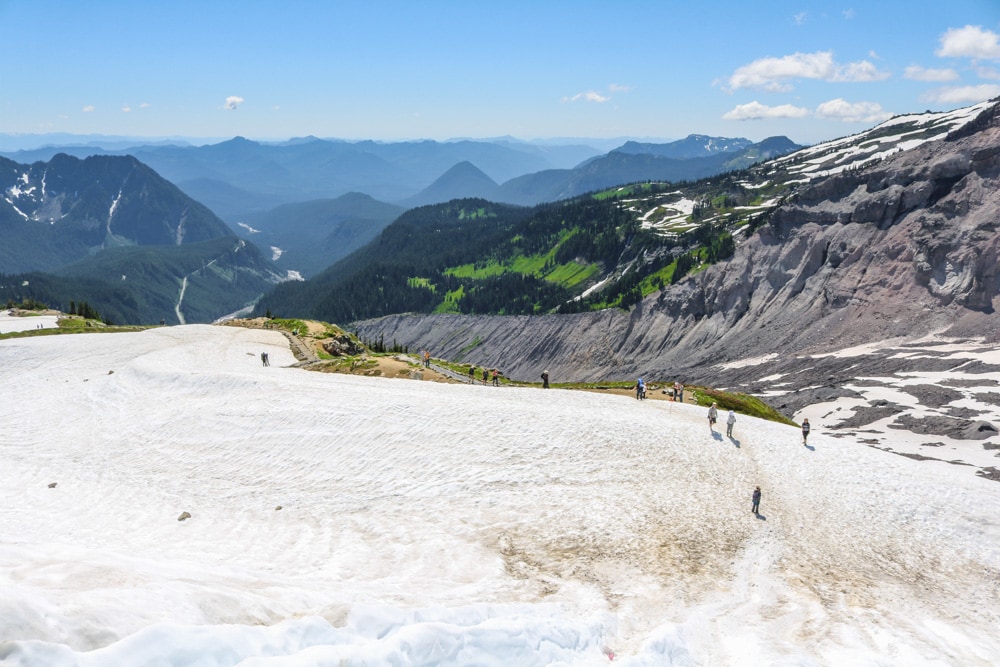
Visiting Mount Rainier National Park’s Paradise FAQs
Where Is Paradise at Mount Rainier?
Paradise is in the middle of the southern half of Mount Rainier National Park. It is located about 5,400 feet above sea level on the south slope of the mountain.
The distance from the Nisqually Entrance, near Ashford in the southwest of the park, to Paradise is 17.5 miles, which is about a 40-minute drive.
From the Stevens Canyon Entrance in the southeast, which is near Ohanapecosh and Packwood, it’s 21 miles to Paradise, also a 40-minute drive.
How Did Paradise in Mount Rainier Get Its Name?
Paradise got its name after the daughter-in-law of James Longmire, Martha, exclaimed “Oh, what a paradise!” upon seeing the area’s meadows, streams, and wildflowers sometime in the 1880s.
The name stuck and has been the official name of this part of Mount Rainier National Park since the park’s creation in 1899.
You can learn more about the history of Mount Rainier National Park here.
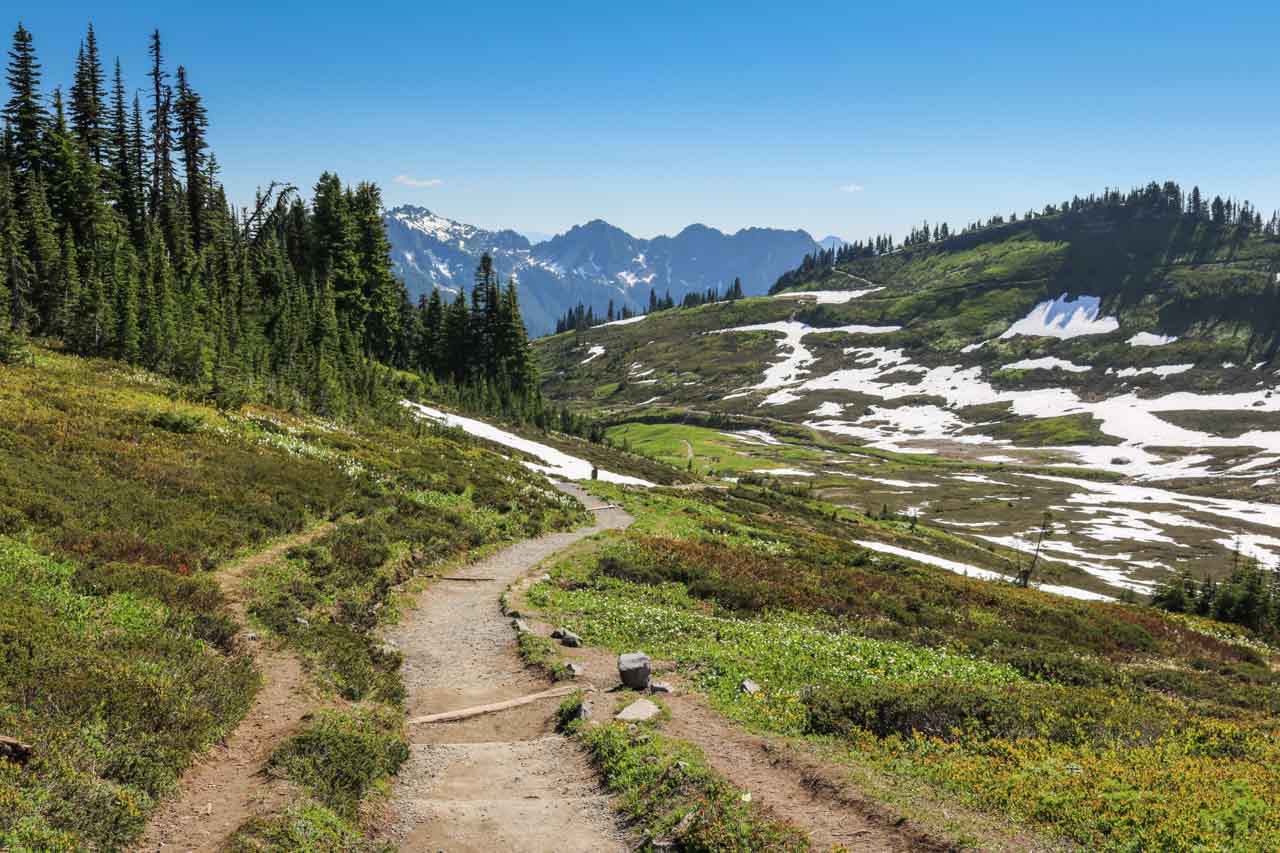
How Many Days Do I Need to Explore Paradise?
You can get a taste of Paradise in just a few hours. In that timespan, you can walk some of the short meadow trails, visit the Paradise Inn, drive the Paradise Valley Road, and see Reflection Lakes.
However, I’d strongly recommend spending two days in this area.
Whether you stay at the Paradise Inn or camp at the nearby Cougar Rock Campground, you won’t regret enjoying these beautiful landscapes at sunrise or sunset. Dawn and dusk are much quieter than middays and afternoons, when the parking lot fills with the cars of day visitors.
Two days allow you to really immerse yourself in the area’s stunning scenery. You’ll be able to do all of the top things to do at Paradise in Mount Rainier National Park I’ve described above.
Is Mount Rainier’s Paradise Open Year-Round?
Yes, Paradise is usually open throughout the year. In fact, it’s one of just two areas in Mount Rainier National Park that’s vehicle-accessible year-round.
Even in winter, Paradise attracts many visitors, who come to enjoy the park’s abundant snowfall. Note, however, that severe winter weather may cause the temporary closure of the road between Longmire and Paradise.
While summer boasts beautiful wildflowers and fall comes with amazing Mount Rainier foliage, winter provides activities like cross-country skiing, snowshoeing, and sledding at Paradise.
You can find a wealth of information about visiting Paradise year-round, including the status of trails and roads, and opening times here.
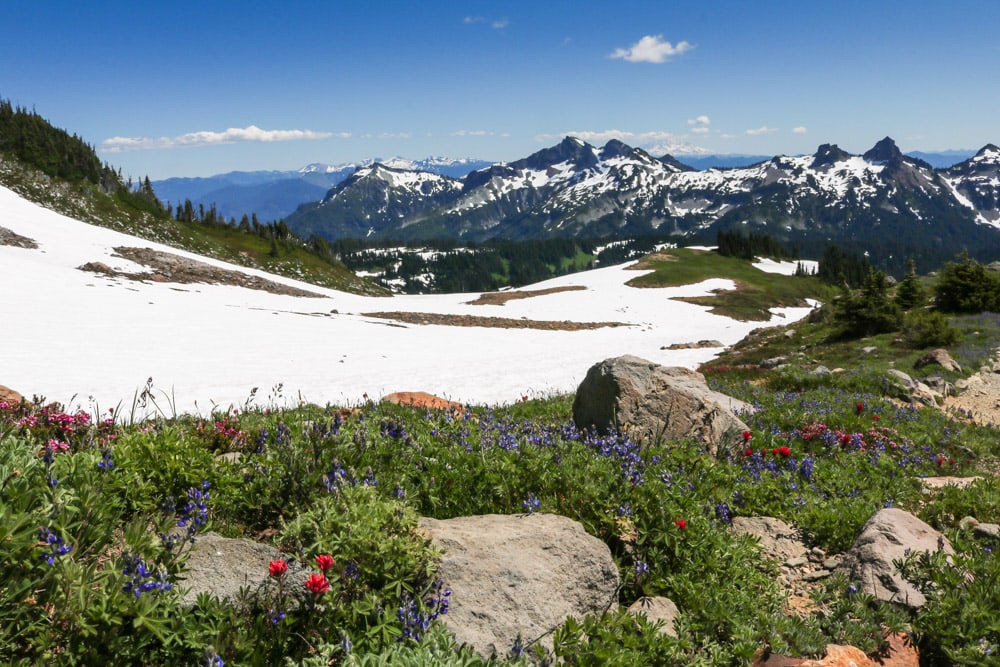
What Is the Best Time to See the Paradise Wildflowers?
Snow often lingers on the slopes of Paradise until well into June, sometimes even July. Most of the Paradise wildflowers start blooming once the snow has almost melted.
Therefore, the best time to enjoy the flowers at Paradise is from mid-July to late-August, which is the peak blooming season. The most impressive wildflower displays at Paradise are typically in early-August.
For more details about the wildflowers in Mount Rainier National Park, including current blooming status, I’d like to refer you to the park’s wildflower page.
Are Pets Allowed at Paradise in Mount Rainier National Park?
Yes, pets are technically allowed at Paradise, but there are many restrictions as to where they can go.
For example, pets are prohibited on all trails and in all buildings. The only places you can take your pet, which must be on a leash at all times, are parking lots and public paved roads.
Which Visitor Services Are Available at Paradise?
Paradise is main visitor area in Mount Rainier National Park and has numerous facilities and services.
- Henry M Jackson Memorial Visitor Center – general information, exhibits, park film, deli, gift shop, ranger programs.
- Paradise Inn – a variety of rustic rooms in a historic national park lodge. See rates and availability here.
- Plaza Restrooms – public restrooms located adjacent to the visitor center.
- Paradise Picnic Area & Restrooms – picnic area and overflow parking west of the lower parking lot.
- Paradise Wilderness Information Center – information about backcountry trips, including wilderness permits.
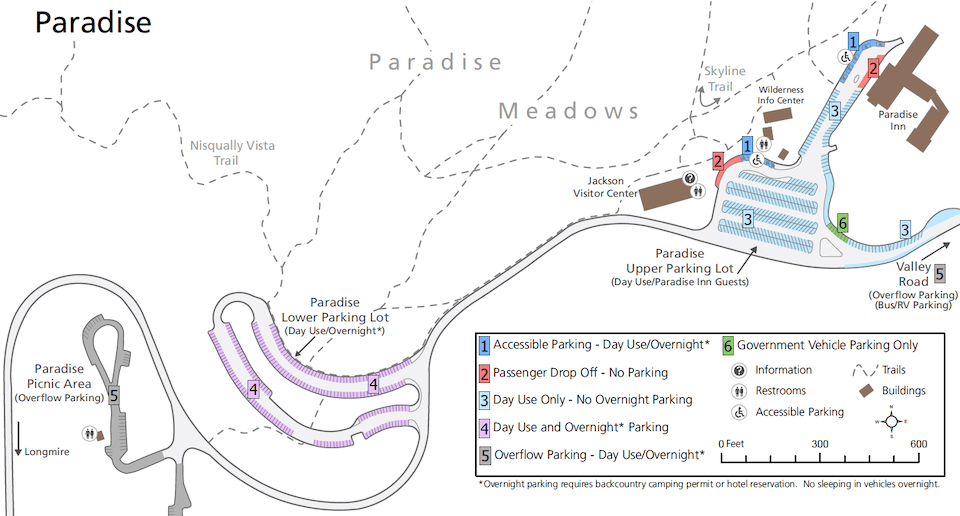
More About Mount Rainier National Park
- Park Website
- Travel Guide
- Topographic Map
- Best Mount Rainier Hikes
- Top Things To Do in Mount Rainier National Park
- Best Views of Mount Rainier
- Accommodation
